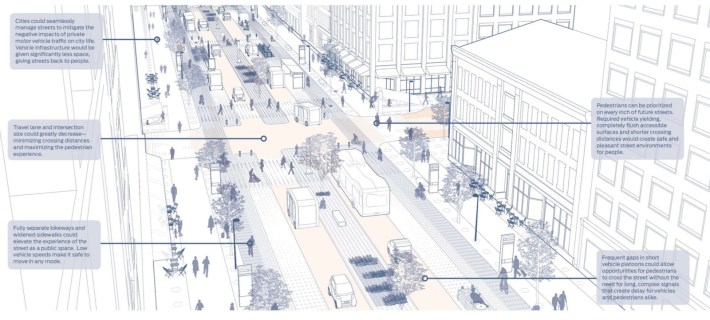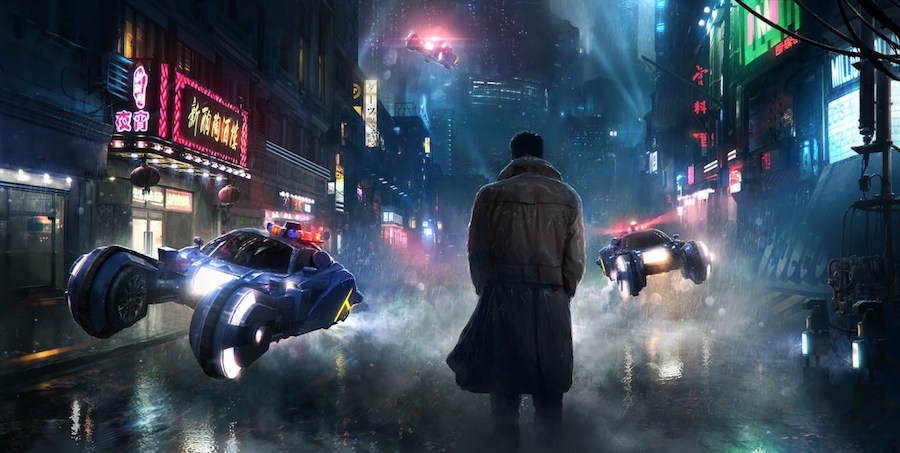[Streetsblog editor John Greenfield publishes a weekly transportation column in the Chicago Reader. We syndicate the column on Streetsblog Chicago after it comes out online.]
The National Association of City Transportation Officials held its annual conference on recently in the Loop, drawing some 800 leaders, planners, and advocates. Workshop topics included “Bringing racial and social equity into transportation planning,” “Designing streets for kids,” “Breaking barriers to cycling,” and “Introducing empathy into the public process” (which discussed how to deal with Parks and Recreation-style meltdowns from NIMBYs at community meetings).
During one of the breakout sessions, the coalition released “Blueprint for Autonomous Urbanism,” a guide to ensuring that self-driving vehicles do more good than harm. It’s a crucial issue, because experts say the future of cities such as Chicago will depend on leaders being proactive about regulating the technology, rather than letting automobile companies and tech entrepreneurs disrupt the current transportation system at will.
In an oft-cited 2014 article in CityLab, Zipcar founder Robin Chase laid out the potential outcomes of the rise of autonomous vehicle technology as "heaven" or "hell." In the best-case scenario, self-driving cars, taxis, and buses will help make Chicago’s streets and regional transportation system safer, more efficient, and more equitable. We won’t have to worry about autonomous vehicles speeding, blowing reds, or failing to yield to pedestrians, as is often the case with human-driven automobiles. Microtransit vehicles with a handful seats, at various price points and luxury levels, will be an option for door-to-door trips, greatly reducing the demand for private cars and parking spaces.
The el and Metra will still be popular ways to get around, but a greatly reduced need for curbside parking will make way for car-free lanes for driverless buses, shortening travel times and boosting ridership. There will also be more room for wider sidewalks and protected bike lanes, plus additional sidewalk cafes, plazas and parks. And eliminating garage parking from residential developments—which costs developers up to $50,000 per space, according to researchers—will help make housing more affordable, because developers typically pass parking construction costs onto residents in the form of higher condo prices and apartment rents.
On the other hand, if market forces are given unfettered authority to shape the rollout of autonomous vehicles in Chicago, the city could wind up with a dystopian landscape straight out of a Blade Runner film. Automobile company executives surely relish the idea of selling autonomous vehicles to every household that can afford them. Since the owners of driverless cars won’t have to worry about finding or paying for parking at their destinations, those who previously commuted by rail or bus might not think twice about taking a private vehicle to their Loop offices or nightlife districts where on-street spaces can be hard to find.
It will also be tempting to send unmanned vehicles out at various times of day to run errands for us, such as picking up dry cleaning or takeout food (an employee would place the goods in the unlocked car) or have them circle the block while we shop. The result will be streets and highways that are even more clogged with cars, while transit ridership and revenue falls and service deteriorates for those who can’t afford the new technology. Moreover, if it’s possible to sleep in or watch a movie while your autonomous vehicle squires you directly from your home to your workplace, a two-hour-plus car commute might not seem so onerous, which could push suburban sprawl far beyond the Fox River.
“Blueprint for Autonomous Urbanism” outlines strategies to prevent the latter outcome. “As cities guide the autonomous revolution, we want technology to solve our mobility challenges; not settle for more of the same,” NACTO president Seleta Reynolds said in a statement accompanying the document. “This blueprint will help cities everywhere lay the foundation for 21st century streets designed to serve people first and foremost, no matter how they travel.”

The guide notes that safety should be the top priority when determining policies governing driverless vehicles, with self-driving vehicles being required to yield to people on foot and bikes. It asserts that, contrary to what might be most convenient for car manufacturers, vulnerable road users shouldn’t be required to carry sensors or signals to avoid being struck. Speed limits should be set at 20 mph, 25 in limited circumstances, with lower speeds in dense central business districts and on residential streets.
NACTO states that fixed-route transit should continue to serve as the backbone of city transportation, while autonomous cars can provide first- and last-mile connections to get residents to and from stations. Instead of widening roads to make room for single-occupancy autonomous vehicles, more street space should be dedicated to space-efficient modes such as driverless buses, streetcars, and trains.
The blueprint notes that cities will receive the greatest benefits from autonomous vehicle technology if they’re able to access data from the cars in real time. For example, this could allow them to collect tax revenue based on miles driven, which will become increasingly important as more vehicles run on electricity rather than gasoline, and provide financial disincentives for single-occupant or zero-occupant robocar trips. The data could also be used to minimize the number of vehicles needed to move people and freight, and maximize efficient routing.
As on-street parking becomes less necessary, NACTO recommends doing away with curbs in most locations and making sidewalks flush with the street, with separation of pedestrian and vehicle space provided by bollards and different colors and textures of pavement. This would eliminate the need for wheelchair ramps at corners and give sidewalk users more options for crossing the street. The Chicago Department of Transportation recently piloted this strategy by turning Uptown’s “Asia on Argyle” commercial district into a mostly curbless “shared street.”
NACTO also recommends that cities get ready for a future in which there’s a much lower demand for car parking by reducing or abolishing parking space minimums for new construction, and requiring that garages be designed so that they can easily be retrofitted to other uses, such as housing. Chicago’s recently enacted transit-oriented development ordinance, which waives the car-parking requirement for projects near transit stations, is a step in the right direction.
The main takeaway from the NACTO blueprint is that municipalities like Chicago can’t afford to be passive as the predicted autonomous vehicle revolution unfolds. Portland Bureau of Traffic policy specialist Art Pearce hammered home that point during a November 2 panel discussion on driverless cars hosted by Chicago’s Metropolitan Planning Council. “The first key thing that every city should be doing is explicitly saying, here are the outcomes that we want to see happen and here are the ways that we think autonomous vehicles can fit into that future vision,” he said. “The cities that are saying, ‘We’re going to wait and see for the next ten years and then join the evolution,’ are really going to suffer.”
CDOT spokesman Mike Claffey promises that Chicago won’t make that mistake. “As the NACTO report makes clear, [autonomous vehicle] technology is coming and it has tremendous potential for improving safety and mobility,” he says. “NACTO has performed a service in laying out the issues that will have to be addressed to ensure that the technology helps us achieve the potential benefits. As a city, we remain open to new technology and innovations in this industry.”
Active Transportation Alliance director Ron Burke echoes Pearce’s advice that the time to take action on regulating driverless cars is now. “Today, policies are largely missing, but we see some troubling ideas emerging such as proposed federal legislation that would restrict local governments’ control of their own streets, ostensibly to accommodate [autonomous vehicles],” he says. “It will be important for Chicago to develop a comprehensive approach that moves us in the right direction, and for active transportation advocates to not cede the agenda solely to the mobility industry and academia.”
In other words, Washington politicians, Detroit automakers, and Silicon Valley tech companies shouldn’t be behind the wheel of our city’s driverless future.





